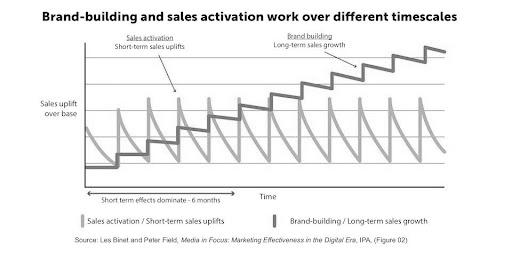Over a decade ago, I joined my first adtech company after kicking off my career in the traditional advertising agency world. And for approximately that same amount of time, I’ve been writing bylines for executive thought leaders at a multitude of companies about three things:
- The cannibalization of the adtech industry
- The death of the cookie
- The impending AI boom
At a certain point, it all became white noise. The industry news equivalent of Bill Murray’s character waking up to “I’ve Got You, Babe” for the hundredth time in Groundhog Day. “Yes”, all of us marketers said to ourselves, “The cookie will die, AI will take our jobs, the industry will continue to consolidate until it forms a hulking monolith where creativity goes to die. In the meantime, how can I prove the quantitative value of our latest brand awareness campaign?”
And that very line of thinking, dear reader, is the reason marketing is not dead (neither, incidentally, is the cookie). Because while we balance the simultaneously ever-changing and yet ever-static news of our industry, we also still have work to do. As Hitchhiker’s Guide to the Galaxy reminds us, we really only have one job amidst the chaos: Don’t Panic. And ideally, we can take that one step further and not only resist panic (or worse, indifference), but also embrace curiosity.
We’ve woken up in Punxsutawney again. How will we change things up?
Bust that Black Box Wide Open
Succeeding in today’s adtech landscape isn’t necessarily about being the best. It’s about innovating at the fastest pace (as a wise CEO once told me, the fast eat the slow), and being willing to put your assumptions to the test with a truly objective eye and be radically transparent about what you find. Once upon a time, it was acceptable for adtech companies to operate in a black box, waving clients off with a pat on the head and a “you don’t have to worry about that”. But now, with AI democratizing analytics at breakneck speed, the black box needs to be replaced with a crystal clear swimming pool.
Go ahead, invite your customers to dive right on into the data. Let them play with it, understand it, ask questions about it. This is a critical shift away from the profoundly overused “proprietary” workings of organizations just a few short years ago. Successful organizations, and successful marketers, should now hang their hats not on secrets kept, but on knowledge shared.
This is really just a natural progression of the transparency that came for consumers with GDPR and CCPA. While we have been regulated into greater transparency for the ultimate audience of our media, there is still a substantial amount of gatekeeping between adtech companies and the organizations they serve.
The best, easiest, and most criminally back-burnered way to stand out and create greater transparency is with a Customer Advisory Board. Adtech is no longer standing on the mountain with a megaphone yelling down to others at base camp what it’s going to be doing. This is a serious two-way conversation, and organizations that invite that conversation with their customers, rather than ignore it, will come out on top.
So, talk to the folks who love your product, the folks who hate it, the folks who gave you that criminal “6” rating on your CSAT. Invite them into a conversation, actually utilize the amazing product marketers you probably just have making decks and one-pagers right now, and build a program that breaks you out of the monolith and puts you on the map as the rarest of all things: an adtech company that cares what its customers have to say.
Balance the Long and Short of It
Another thing that never changed in my entire adtech life? The pressure to balance short-term quarterly goals with long-term, sustainable company growth. On the one hand, as Groundhog Day reminds us, nothing that you do in a single day matters if the day is simply doomed to repeat itself again. Hello, Sisyphus.
This is how it can often feel when launching a new program without any guarantee that you’ll be able to run it long enough to produce results. “This webinar didn’t work” is something I often heard, despite the reality that a single webinar never works. An ongoing webinar program does. Yet it can be hard to see the forest through the trees when the arguments from one side of the house for short-term needs are concrete, and the value of longer-term programs can come across as theoretical.
So, what’s a modern marketer to do? Hedge your bets, and back your opinions with data. The best advances always come from a test and learn approach that allows you to share progress (whether good or bad) at a consistent cadence and demonstrate the changes you’re making along the way. Sprints of two weeks to one month for demand generation activities gave me the boost I needed toward short-term goals while also buying me the breathing room to focus on the long game.
As we all know, the best laid strategy will always be better received with objective data to back it up. My personal favorite marketing chart [below] details the manner in which sales and demand-focused activations can lead to a shorter term boost in sales, but ultimately it is brand awareness that leads to sustainable success over 12+ months.
If I had a nickel for every time this chart appeared in a deck and helped me get more budget for experimentation and a test and learn approach, I would have at least enough nickels to buy a coffee for the person who originally shared it with me.

The Day After Groundhog Day
While there is no guarantee of escaping the certain inevitable loops of any industry, there is always a path to innovation, experimentation and improvement. When you pair radical transparency across your customer base with a data-driven, test-and-learn approach that equally balances long and short term internal goals, you’ll find yourself in solid fighting shape to survive the cannibalization of adtech, the impending coup of our AI overlords, and – if it ever actually were to happen – the death of the cookie.
Rachel Peterson is a former marketing executive specializing in enterprise software with a track record of scaling multiple B2B companies to $100M+ in ARR. She now works as an author and consultant.







